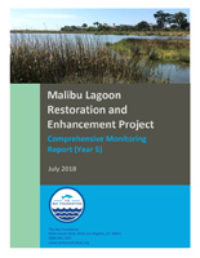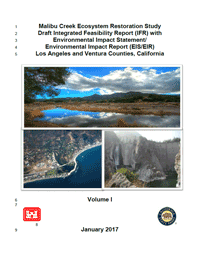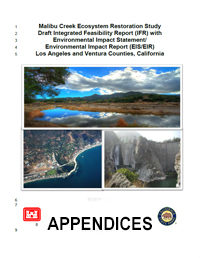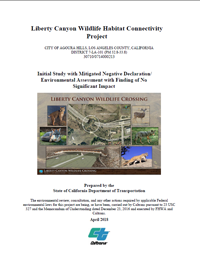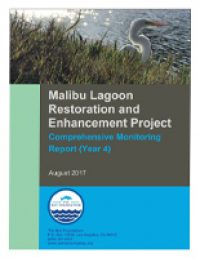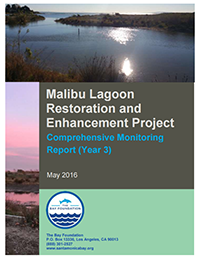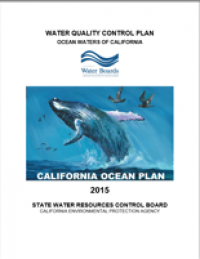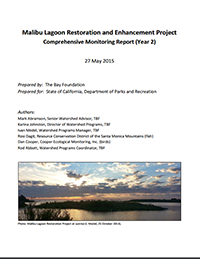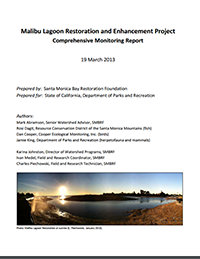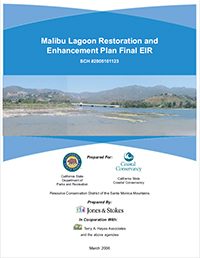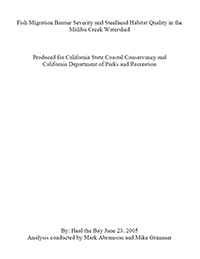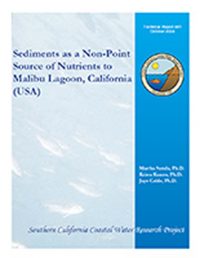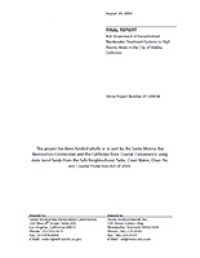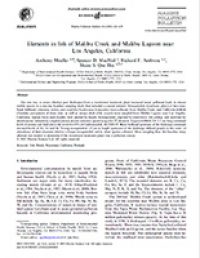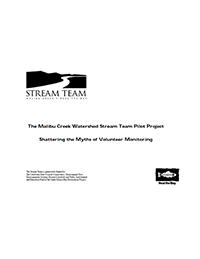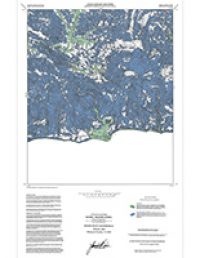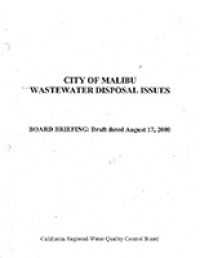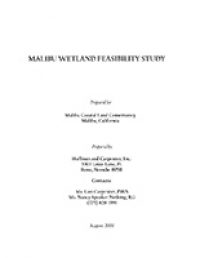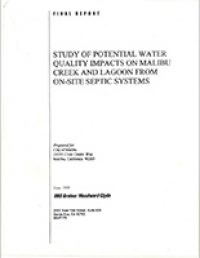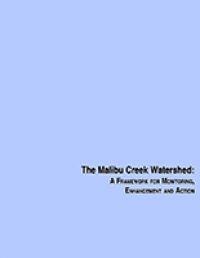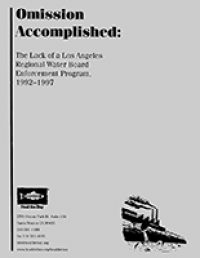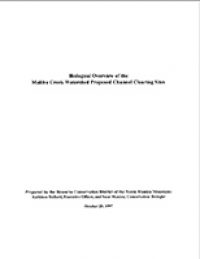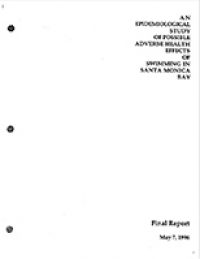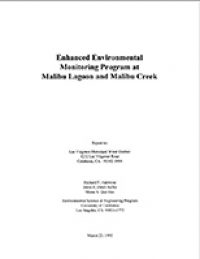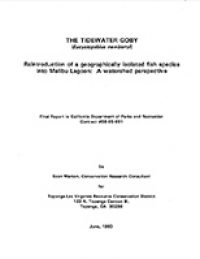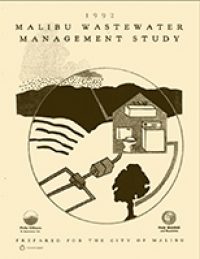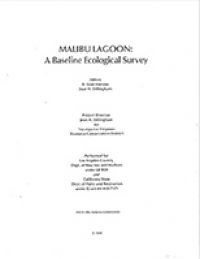STUDIES
ARTICLE
DESCRIPTION
Malibu Lagoon Restoration and Enhancement Project Comprehensive Monitoring Report (Year 6). Prepared by The Bay Foundation for the California Department of Parks and Recreation. K. Johnston, M. Grubbs, C. Enyart, R. Dagit, D. Cooper, August 2019.
The Malibu Lagoon restoration project has been determined to be wholly successful as assessed against project goals and success criteria.
Malibu Lagoon Restoration and Enhancement Project Comprehensive Monitoring Report (Year 5). Prepared by The Bay Foundation for the California Department of Parks and Recreation. R. Abbott, M. Abramson, D. Cooper, R. Dagit, M. Grubbs, and K. Johnston. August 2018.
A comprehensive evaluation comparing pre-restoration conditions to conditions following the March 2013 restoration of Malibu Lagoon through analyses of physical, chemical, and biological monitoring components.
Malibu Creek Ecosystem Restoration Study Draft Integrated Feasibility Report (IFR) Environmental Impact Statement /Environmental Impact Report (EIS/EIR)
Los Angeles and Ventura Counties, California. Prepared by the Army Corps of Engineers for the California Department of Parks and Recreation January 2017.
This Draft Integrated Feasibility Report with Environmental Impact Statement/Environmental Impact Report presents a summary of the planning process, describes the affected environmental resources and evaluates the potential impacts to those resources as a result of constructing, operating and maintaining the Malibu Creek Ecosystem Restoration Study. The purpose of the study is to restore aquatic habitat connectivity along Malibu Creek and tributaries, establish a more natural sediment regime from the watershed to the shoreline, and restore aquatic habitat of sufficient quality along Malibu Creek and tributaries to sustain or enhance indigenous populations of aquatic species.
APPENDICES for Malibu Creek Ecosystem Restoration Study Draft Integrated Feasibility Report (IFR) Environmental Impact Statement /Environmental Impact Report (EIS/EIR).
Appendix A Agency Coordination and Public Involvement
Appendix B Hydrology, Hydraulics and Sedimentation
Appendix C Civil Design and Structural
Appendix D Geotechnical Engineering
Appendix E Economics
Appendix F Cost Engineering
Appendix G Real Estate
Appendix H 404 (B) 1 Evaluation
Appendix I Monitoring and Adaptive Management Plan
Appendix J Habitat Evaluation
Appendix K Cultural Resources
Appendix L Air Quality
Appendix M Noise
Appendix N Traffic
Appendix O Coastal Engineering
Appendix P Coordination Act Report (CAR)
Appendix Q Distribution List
Technical Appendices for the Draft Integrated Feasibility Report with Environmental Impact Statement/Environmental Impact Report.
Liberty Canyon Wildlife Habitat Connectivity Project:Initial Study with Mitigated Negative Declaration/ Environmental Assessment with Finding of No Significant Impact. Prepared by the State of California Department of Transportation. April 2018..
Initial Study with Mitigated Negative Declaration/Environmental Assessment with Finding of No Significant Impact.
Malibu Lagoon Restoration and Enhancement Project Comprehensive Monitoring Report (Year 4). The Bay Foundation. R. Abbott, M. Abramson, D. Cooper, R. Dagit, M. Grubbs, and K. Johnston. August 2017.
A comprehensive evaluation comparing pre-restoration conditions to conditions following the March 2013 restoration of Malibu Lagoon through analyses of physical, chemical, and biological monitoring components.
Malibu Lagoon Restoration and Enhancement Project Comprehensive Monitoring Report (Year 3). The Bay Foundation. R. Abbott, M. Abramson, D. Cooper, R. Dagit, M. Grubbs, and K. Johnston. May 2016.
A comprehensive evaluation comparing pre-restoration conditions to conditions following the March 2013 restoration of Malibu Lagoon through analyses of physical, chemical, and biological monitoring components.
Water Quality Control Plan – Ocean Waters of California. State Water Resources Control Board/Cal. EPA. 2015.
The State Water Board declares that protection of the quality of the ocean* waters for use and enjoyment by the people of the State requires control of the discharge of waste* to ocean* waters and control of intake seawater*. The Board finds further that this plan shall be reviewed at least every three years to guarantee that the current standards are adequate and are not allowing degradation* to marine species or posing a threat to public health.
Malibu Lagoon Restoration and Enhancement Project Comprehensive Monitoring Report (Year 2). The Bay Foundation. R. Abbott, M. Abramson, D. Cooper, R. Dagit, K. Johnston, and I. Medel. May 2015
A comprehensive evaluation comparing pre-restoration conditions to conditions following the March 2013 restoration of Malibu Lagoon through analyses of physical, chemical, and biological monitoring components.
Malibu Lagoon Restoration and Enhancement Project Comprehensive Monitoring Report. Santa Monica Bay Restoration Foundation. M. Abramson, D. Cooper, R. Dagit, K. Johnston, J. King, I. Medel, and C. Piechowski. March 2013.
A comprehensive evaluation comparing pre-restoration conditions to conditions following the March 2013 restoration of Malibu Lagoon through analyses of physical, chemical, and biological monitoring components.
Malibu Lagoon Comprehensive Monitoring Report – Appendices. Santa Monica Bay Restoration Foundation. March 2013
Appendices for the 2013 Malibu Lagoon Restoration and Enhancement Project Comprehensive Monitoring Report Year 1. The report is comprehensive evaluation comparing pre-restoration conditions to conditions following the March 2013 restoration of Malibu Lagoon through analyses of physical, chemical, and biological monitoring components.
Malibu Creek Watershed – Ecosystem on the Brink
S. Sikich, K. Pease, S. Diringer, M. Abramson, M. Gold, S. Luce. 2013.
The Malibu Creek Watershed is the second largest watershed draining to the Santa Monica Bay. Despite its location in one of the largest urban areas in the world, the 110-square mile watershed is dominated by open space. Over 75% of the Malibu Creek Watershed is undeveloped, with several small cities and rural residential communities located within its reaches.
Malibu Lagoon Restoration and Enhancement Plan Final EIR March 2006
Prepared by Jones & Stokes Prepared for: California State Coastal Conservancy, California State Department of Parks and Recreation, and the Resource Conservation District of the Santa Monica Mountains
The Malibu Lagoon Restoration and Enhancement Plan (Plan) Environmental Impact Report {EIR} presents a comprehensive and adaptive management approach to restore and enhance the ecological structure and function of Malibu Lagoon, improve lagoon and coastal water quality, and enhance visitors’ experience through improvements to access and interpretive displays. The Plan includes a water management component, a habitat and access plan, and a comprehensive long-term monitoring plan to ensure restoration goals are being achieved. The Plan was selected out of a range of alternatives for its ability to achieve restoration goals while minimizing short-term impacts to the existing system.
Santa Monica Mountains Steelhead Habitat Assessment Final Project Report. California Trout. January 18, 2006
Results of comprehensive stream habitat and barrier assessment surveys on 13 focal watersheds in the Santa Monica Mountains to identify, prioritize, and suggest restoration efforts in to restore the federally endangered southern steelhead trout. 13 watersheds were surveyed and analyzed to identify and prioritize which streams should be selected for steelhead restoration actions and to recommend specific prioritized restoration actions and estimate the costs of such actions.
Malibu Lagoon Restoration and Enhancement Plan. Moffatt & Nichol. June 2005
This Malibu Lagoon Restoration and Enhancement Plan presents detailed information to implement and monitor the preferred restoration alternative. The preferred alternative is alternative 1.5, as specified in the Malibu Lagoon Feasibility Study Final Alternatives Analysis. Implementation details are provided in the form of plans for water management, habitat management, access, and monitoring to facilitate implementation of the monitoring program and subsequent environmental review and permitting.
Fish Migration Barrier Severity and Steelhead Habitat Quality in the Malibu Creek Watershed. M. Abramson and M.Grimmer. Heal the Bay June 2005.
Evaluates Heal the Bay Stream Team fish habitat and steelhead barrier survey data collected between 2003 and 2005 to determine existing habitat quality and additional stream miles accessible to increase steelhead trout populations in the Malibu Creek Watershed. The report prioritizes the top 10 barrier removal projects to recover the species.
Sediments As A Non-Point Source Of Nutrients To Malibu Lagoon. Sutula, Kramer, Cable/Water Board. October 2004.
This study addressed three major questions that are relevant for refining the Water Quality Objectives in the Malibu Lagoon: 1) What is the load of N and P associated with the wet season input of sediments into the Lagoon? 2) What is the exchange of N and P between the surface waters from the sediments? 3) What are the other sources of N and P to the Lagoon and how does N and P remobilized from sediments compare with these sources? 83 pages.
The Malibu Creek Watershed Stream Team Pilot Project
Shattering the Myths of Volunteer Monitoring. Abramson, et. al. Heal the Bay. 2002.
November 1998- 2001, Heal the Bay conducted extensive testing to determine that the Stream Team Volunteer Monitoring Program and Stream Team Field Kit provide accurate, reliable and precise water quality data that can be used for watershed assessment and subsequent resource management decisions. This report documents the results of that testing and estimated cost savings using community volunteers to collect data.
CA Seismic Hazard Zones-Malibu Beach Quadrangle. James Davis/Cal State. October 2001.
|
This Malibu Beach Quadrangle map will assist cities and counties in fulfilling their responsibilities for protecting the public safety from the effects of earthquake-triggered ground failure as required by the Seismic Hazards Mapping Act (Public Resources Code Sections 2690-2699.6). 1 page. |
.
Lower Malibu Creek and Lagoon Resource Enhancement & Management. R. Ambrose/A. Orme/UCLA. May 2000.
The study involved eight major objectives for the lower watershed, namely an analysIs and interpretation of (1) evolution and historical development, (2) hydrology and morphodynamIcs, (3) biologIcal and water qualIty objectives and habitat associations, (4) vegetation, (5) eutrophication, (6) pathogens, (7) hydrologic alteration and human disturbance, (8) management alternatives, and (9) wetland restoratIon. The Final Report is organized under these categories, together wIth (10) a summary of management and restoration alternatIves, and (11) a concluding perspective.
Malibu Creek Watershed: A Framework for Monitoring, Enhancement and Action. Abramson, Padick, Schuman, Taylor/Heal the Bay, Coastal Conservancy. August 1998.
This design is for a long term citizen volunteer monitoring program to evaluate the water quality in the entire Malibu Creek Watershed and target areas for future studies, protection, restoration and enhancements. 156 pages
Ommissions Accomplished: Lack of a Los Angeles Water Board Enforcement Program 1992-1997. Steve Fleischli, Mark Abramson, Mark Gold, Jaque Forrest, Jenny Harbine/Heal the Bay. January 1998.
General assessment to determine the extent the Los Angeles Regional Water Board’s enforcement efforts over the past six years and provide recommendations for improvements. 69 pages.
Enhanced Monitoring Program. Heather Trim/SM Bay Project. November 1994. Ambrose, Suffet, Hee/NRDC, Heal the Bay, Env. Now, Tapia & Triunfo District. March 1995.
Assessment of effects of anthropogenic inputs into the creek and lagoon on the physical, chemical and biological processes in the creek and lagoon. 377 pages.
Malibu Lagoon: A Baseline Ecological Survey. J. Dillingham, S. Manion. March, 1989
This study gathered baseline ecological and physical data of the Malibu Lagoon ecosystem for the full year cycle from May 1987 through June 1988 by measuring and documenting physical and ecological conditions This is the first study of such wide scope undertaken for the Malibu Lagoon. 167 pages.


